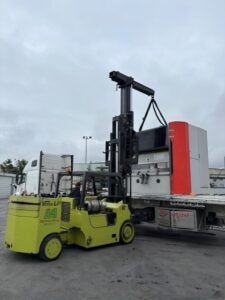-
10 Important Steps for an Industrial Plant Relocation
Why Industrial Plant Relocation Demands Careful Planning
Relocating a business is no small task, but moving an industrial plant takes complexity to a whole new level. From moving massive machinery and transporting intricate systems to handling specialized materials and everything in between, every facet of a plant relocation demands precision and a careful plan of action. The sheer complexity of relocating industrial equipment, combined with the risks involved in handling sensitive items and hazardous substances, makes having a clear roadmap vital to your business move.
A smooth, successful plant relocation calls for a thoughtful approach, detailed coordination, and the right strategies to keep your operations on track. Our guide will break down the process of tackling such a significant move into ten clear, actionable steps. Let’s outline the steps you should add to your moving checklist so you can get to your new location and back to business as efficiently as possible.

10 Important Steps for an Industrial Plant Relocation
1. Start with Clear Goals and a Realistic Timeline
Every great move starts with a clear purpose. Defining the key goals for your industrial plant relocation is essential for success. Are you relocating to expand operations, improve cost efficiency, or better align with strategic partners? Once your objectives are crystal clear, establish a timeline that accounts for each major phase – preparing the new facility, transferring equipment, restarting production, and scaling back to full capacity. Build in some extra time to handle the small challenges that often arise during a complex factory relocation process.
2. Catalog Your Assets In a Detailed Inventory
Every successful industrial plant relocation starts with clarity, and detailed documentation of your assets sets a crystal-clear starting line. Catalog every asset being relocated – production machinery, tools, IT systems, and office furnishings – along with their dimensions, weight, and power requirements. Don’t overlook raw materials, in-progress goods, or finished products in storage, as these are just as critical to track. By accounting for all these elements, you’ll set the foundation for an organized transition that leaves no asset behind.
3. Plot Your Plant’s New Location
A little foresight now can save a lot of scrambling later. Create a detailed map of your new facility to pinpoint exactly where each asset will go. It’s easy to underestimate how much effort unplanned decisions at the site can take. Focus on positioning major equipment, but don’t ignore smaller items – they matter, too. This careful mapping process will make your manufacturing plant relocation smoother and give you a clearer path to operational success.
4. Tap into Your Team’s Hands-On Expertise
Your workforce is the backbone of a successful manufacturing plant relocation. The individuals who operate and maintain equipment daily hold a wealth of knowledge that can streamline the process. Collaborate with them to develop a detailed plan for safely preparing and moving critical assets. Incorporate their recommendations early to prevent last-minute surprises and ensure everything is ready on time. Their expertise is invaluable for making the move as efficient as possible.
5. Draft Specific Instructions for Contractors
Handing off tasks to contractors and third-party service providers during a plant relocation will be a game-changer, but only if they know exactly what to do. Create detailed, no-nonsense instructions that outline their responsibilities step by step. This guidance should be simple and easy to reference, especially when supervising employees are pulled away or unavailable. Clear communication keeps everyone on the same page and the relocation on track.
6. Prepare the Path for Your Assets
Getting assets from point A to point B during a plant relocation is more than just loading trucks. From stationery and administrative tools to heavy machinery and high-risk materials, every asset’s exact route throughout the move should be mapped out inside and out. Will oversized items need wider openings or floor protection? Check for necessary permits if public roads are part of the plan. Preparing for these logistical details ahead of time helps avoid hiccups and keeps your facility relocation running according to plan.
7. Handle Hazardous Substances with Care
Dealing with dangerous materials isn’t something you want to take lightly when moving your business. If hazardous substances are part of your move, knowing their properties and handling them correctly is crucial. Ensuring safety means working with experts who understand hazmat protocols and have the tools to transport these items securely. A professional relocation team experienced in this area can help make the process smooth, efficient, and compliant with regulations, giving you one less thing to stress over.
8. Coordinate With Utility Providers
Timing is everything during plant relocation, especially when it comes to keeping your utilities flowing uninterrupted. If power, water, or other services need to be disconnected or activated, make sure they’re ready to go at your new location by coordinating with your service providers early on in the process. Avoid delays by scheduling these changes well in advance so operations resume without a hitch at your facility’s new location.
9. Perform Post-Move Inspections & Safety Reviews
You’re almost there, but before operations fully pick up in your new space, it’s vitally important to conduct thorough equipment inspections and safety reviews. Inspect and test relocated equipment to confirm everything is functioning correctly and safely. Walk through workflows with your team, conduct trial runs, and compare results to previous benchmarks to ensure processes are on track. Use this time to troubleshoot and fine-tune anything that needs adjustment. Plant relocation success depends on making sure safety training, certifications, and approvals are all in place before ramping up to full production.
10. Partner With a Skilled Factory Relocation Company
Why go it alone when experts are ready to make your plant relocation seamless? Partnering with a full-service factory relocation company means gaining a trusted ally with years of hands-on experience and a proven track record of success. Industrial moving professionals will handle all the complexities with ease and ensure every detail is expertly managed. With professional factory relocation services, you also benefit from comprehensive guidance throughout the process. Get a clear quote upfront, then lean on their expertise to simplify and streamline every phase of your move.
Success Lies in Strategic Execution
Relocating your factory might feel overwhelming, but with the right partner, it doesn’t have to be. LA Machinery Moving offers a complete suite of factory relocation services that prioritize efficiency and precision every step of the way. From secure crating, packaging, and short-term storage to heavy equipment shipping and expert reinstallation, we are your comprehensive source to keep your relocation project on time and on budget. Trust our skilled team to handle your move seamlessly. Contact us today to schedule your free estimate and get started.
-
Reasons Why Rigger’s Liability Insurance Is Important
Heavy equipment, high-risk environments, and complex operations are all in a day’s work for riggers. With so much at stake, having the right safety measures in place goes beyond the basics. Riggers’ liability insurance is a vital safeguard for operations that involve lifting, moving, or hoisting heavy loads. It’s there to help safeguard businesses, workers, and property against unexpected incidents.
Whether you’re tackling challenging projects or managing day-to-day tasks, this essential coverage ensures you’re prepared for the risks that come with the job. Knowing why it’s so important is the key to keeping your operations secure and moving forward. Let’s explore why riggers’ liability coverage is a must and what this means for you.

Liability insurance on a wooden table with glasses.
What Is Riggers Liability Insurance?
Handling heavy equipment and machinery you don’t own comes with serious responsibilities, especially when precision and safety are on the line. Riggers’ liability insurance steps in to address the unique risks of transporting or hoisting heavy equipment at the worksite. For example, if machinery is damaged during a lift, rigging insurance helps cover the costs, ensuring you’re not stuck footing the bill. Unlike general liability coverage, riggers’ insurance policies specifically protect property in our possession, both during transport and installation. Ultimately, riggers’ liability coverage, complemented by crane insurance, is an essential safety net that keeps your business prepared for the unexpected.
The Key Risks Covered by Riggers’ Liability Insurance
Hoisting and transporting valuable equipment is no small feat, and mistakes can be costly. That’s where riggers’ liability insurance offers essential protections when handling expensive machinery or materials. Here are four critical risks this coverage addresses to keep projects moving forward without unnecessary setbacks:
- Covers Property Damage – Riggers insurance ensures the cost of repairs or replacements is covered if equipment or property is damaged during a lift.
- Minimizes Project Disruptions – By providing coverage when incidents occur, you’ll help prevent delays that could otherwise stall an entire project timeline.
- Offers Customizable Coverage Options – From one-time projects to annual coverage, riggers insurance adapts to operational demands seamlessly and effectively.
Top Reasons Riggers’ Liability Insurance Is Essential
Handling heavy loads and operating complex machinery comes with significant responsibility. Riggers perform critical work that requires precision, skill, and a mindful approach to safety. While accidents can be rare, the costs of unforeseen incidents can escalate quickly, and proper planning is essential to keep operations running smoothly. That’s where riggers’ insurance plays a pivotal role for both our crew and our clients. Rigging coverage ensures your business is prepared for a variety of potential risks. Here are some primary ways rigger’s insurance safeguards your operations:
- Operator Coverage – Riggers often work in environments that pose physical dangers. Insurance supports operator safety by covering injuries, lost income, and liability risks.
- Compliance Coverage – Regulations are strict in this industry. Insurance helps protect against penalties if equipment inadvertently causes a state law or pollution violation.
- Equipment Coverage – Heavy machinery is vital to your work. Rigger’s insurance ensures that damaged or malfunctioning equipment can be repaired or replaced without disrupting operations.
- Coverage for the Public – Accidents that impact clients or bystanders can be costly. Insurance protects against property damage claims and public liability incidents.
What Could Go Wrong Without Rigger’s Liability Coverage?
Riggers and crane operators are constantly exposed to high-stakes scenarios on the job site, where accidents can happen faster than you think. Without rigging and crane rental insurance, an equipment failure could lead to expensive property damage or even serious injuries that halt progress entirely. A lifting mishap, for example, might damage expensive materials or structures, leaving you with a hefty repair bill. Public liability incidents can also escalate quickly, straining your business financially. Whether hoisting construction beams, installing HVAC systems, positioning large turbines, or transporting sensitive medical equipment, the right coverage ensures these moments don’t derail your operations or your reputation.
Common Misconceptions About Riggers Insurance
It’s easy to misunderstand what rigging liability insurance covers, especially with so many coverage options out there. A common misconception is assuming standard commercial general liability (CGL) policies offer automatic coverage for equipment or property belonging to others in your care, custody, or control. The truth is, CGL policies often exclude this, but a riggers liability endorsement can help fill the gap. However, it’s important to note that this endorsement may not extend to property or goods during transit.
Protect Your Los Angeles Business With LA Machinery Moving
Big challenges call for experts who make it look effortless. At LA Machinery Moving, we set the gold standard for heavy equipment moving services across the Greater Los Angeles area. From commercial to industrial projects, our experienced team handles every aspect of your operation with precision and care. With a focus on safety and thorough planning, we ensure your equipment is transported and installed seamlessly. Plus, with rigging liability insurance integrated into our services, you can trust us to cover all bases. Contact us today to get started on your next move.
